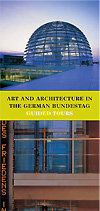Navigationspfad: Homepage > Art and History > Art > Artists
Christo
Born in the town of Gabrovo, Bulgaria, in 1935 and lives and works in New York.
A study made by Christo in 1986 in connection with his Wrapped Reichstag project is displayed in the rooftop restaurant of the Reichstag Building. Christo and Jeanne Claude had to fight for almost two decades before this design sketch could be made a reality with the wrapping of the Reichstag Building. Looking at the study with its muted colouring, one recalls that Christo and his wife, Jeanne-Claude, spent more than two decades drumming up support for the project before the German Bundestag finally voted in its favour in a plenary debate on 25 February 1994.
The wrapping took place in the summer of 1995 and became the occasion for a huge public celebration. As it turned out, the delay in implementing the project gave it a whole new dimension. Originally, as the study in the restaurant makes clear, the symbolic character of the wrapped Reichstag Building derived from its position on the dividing line between East and West. This changed following the reunification of Germany and the decision by the Council of Elders to make the building the seat of the German Bundestag.
Wrapping the Reichstag prior to its remodelling by Norman Foster temporarily concealed the structure’s complexity and presented it as a surprisingly unified block. In this form, it offered an opportunity for taking stock and reflecting on the vicissitudes of the building as a mirror of Germany’s turbulent history. Moreover, Wrapped Reichstag provided a focus for hopes relating to the country’s political future, henceforth to be determined on a nationwide basis in Berlin, as well as the period of uncertainty that inevitably accompanied the far-reaching political and social changes then taking place.


